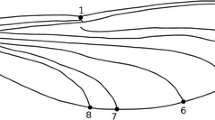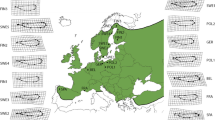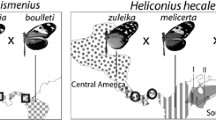Abstract
The genetic structure and phenotypic diversity of a population of Cheilosia naruska Haarto and Kerppola, 2007 (Diptera, Syrphidae) from Lapland, Finland, was examined through allozyme electrophoresis and wing morphometrics. The morphological identification of the species was verified molecularly using partial sequences of mitochondrial COI and the nuclear ribosomal ITS2 genes comparing with corresponding sequences of a paratype of the taxon. Based on protein electrophoresis, out of 12 analyzed allozyme loci, only one locus (Me) was found to be polymorphic. The low genetic variability was further evidenced by the absence of heterozygote genotypes. Fluctuating asymmetry was used as a measure of developmental stability. For this we used different wing traits that were estimated using both wing landmark positions and metric traits. Procrustes ANOVA and Canonical variate analysis revealed asymmetry in wing metric and wing shape and size, and within each sex considered separately. Principal component analysis revealed similar multivariate patterns of landmark covariation between within-individual variability (fluctuating asymmetry) and variation among individuals. Finally, the observed association between lack of heterozygosity and high level of asymmetry is discussed in light of conservation.



Similar content being viewed by others
References
Badyaev AV, Foresman KR (2000) Extreme environmental change and evolution: stress-induced morphological variation is strongly concordant with patterns of evolutionary divergence in shrew mandibles. P Roy Soc B-Biol Sci 267:371–377
Beebe NW, Saul A (1995) Discrimination of all members of the Anopheles punctulatus complex by polymerase chain reaction- restriction fragment length polymorphism analysis. Am J Trop Med Hyg 53:478–481
Birdsall K, Zimmerman E, Teeter K, Gibson G (2000) Genetic variation for the positioning of wing veins in Drosophila melanogaster. Evol Dev 2(1):16–24. doi:10.1046/j.1525-142x.2000.00034.x
Clarke GM (1995) Relationships between developmental stability and fitness: application for conservation biology. Conserv Biol 9:18–24. doi:10.1046/j.1523-1739.1995.09010018.x
Clary D, Wolstenholme D (1985) The mitochondrial DNA molecule of Drosophila yakuba: nucleotide sequence, gene organization, and genetic code. J Mol Evol 22:252–271. doi:10.1007/BF02099755
Claussen C, Ståhls G (2007) A new species of Cheilosia Meigen from Thessaly/Greece, and its phylogenetic position (Diptera, Syrphidae). Volucella 8:45–61
Debat V, Bégin M, Legout H, David JR (2003) Allometric and nonallometric components of Drosophila wing shape respond differently to developmental temperature. Evol Int J Org Evol 57(12):2773–2784
Debat V, Milton CC, Rutherford S, Klingenberg CP, Hoffmann AA (2006) HSP90 and the quantitative variation of wing shape in Drosophila melanogaster. Evol Int J Org Evol 60(12):2529–2538
Francuski Lj, Ludoški J, Vujić A, Milankov V (2009) Wing geometric morphometric inferences on species delimitation and intraspecific divergent units in the Merodon ruficornis group (Diptera, Syrphidae) from the Balkan Peninsula. Zool Sci 26:301–308
Frankham R (2003) Genetics and conservation biology. C R Biol 326:S22–S29. doi:10.1016/S1631-0691(03)00023-4
Frankham R (2005) Genetics and extinction. Biol Conserv 126:131–140. doi:10.1016/j.biocon.2005.05.002
Frankham R, Ballou JD, Briscoe DA (2002) Introduction to conservation genetics. Cambridge University Press, Cambridge
Gilchrist AS, Azevedo RBR, Partridge L, O’Higgins P (2000) Adaptation and constraint in the evolution of Drosophila melanogaster wing shape. Evol Dev 2(2):114–124. doi:10.1046/j.1525-142x.2000.00041.x
Graham JH, Freeman DC, Emlen JM (1993) Antisymmetry, directional symmetry, and dynamic morphogenesis. Genetica 89:121–137. doi:10.1007/BF02424509
Grueber CE, Wallis GP, Jamieson IG (2008) Heterozygosity-fitness correlations and their relevance to studies on inbreeding depression in threatened species. Mol Ecol 17:3978–3984. doi:10.1111/j.1365-294X.2008.03910.x
Haarto A, Kerppola S (2007) Finnish hoverflies and some species in adjacent countries. Otavan Kirjapaino Oy, Keuruu
Haarto A, Kerppola S, Ståhls G (2007) Description of Cheilosia naruska Haarto & Kerppola spec. nov. from northern Europe (Diptera, Syrphidae). Volucella 8:63–72
Hansson B, Westerberg L (2002) On the correlation between heterozygosity and fitness in natural populations. Mol Ecol 11:2467–2474. doi:10.1046/j.1365-294X.2002.01644.x
Hewitt GM (2000) The genetic legacy of the quaternary ice ages. Nature 405:907–913. doi:10.1038/35016000
Hewitt GM (2004) Genetic consequences of climatic oscillations in the quaternary. Philos Trans R Soc Lond B Biol Sci 359:183–195. doi:10.1098/rstb.2003.1388
Hoffmann AA, Woods RE, Collins E, Wallin K, White A, McKenzie JA (2005) Wing shape versus asymmetry as an indicator of changing environmental conditions in insects. Aust J Entomol 44:233–243. doi:10.1111/j.1440-6055.2005.00469.x
Jenkins NL, Hoffmann AA (2000) Variation in morphological traits and trait asymmetry in field Drosophila serrata from marginal populations. J Evol Biol 13:113–130. doi:10.1046/j.1420-9101.2000.00149.x
Kark S, Lens L, Van Dongen S, Schmidt E (2004) Asymmetry patterns across the distribution range: does the species matter? Biol J Linn Soc Lond 81:313–324. doi:10.1111/j.1095-8312.2004.00296.x
Klingenberg CP, McIntyre GS (1998) Geometric morphometrics of developmental instability: analysing patterns of fluctuating asymmetry with Procrustes methods. Evol Int J Org Evol 52(5):1363–1375. doi:10.2307/2411306
Klingenberg CP, Zaklan SD (2000) Morphological integration between developmental compartments in the Drosophila wing. Evol Int J Org Evol 54(4):1273–1285
Leamy L (1984) Morphometric studies in inbred and hybrid house mice. V. directional and fluctuating asymmetry. Am Nat 123:579–593. doi:10.1086/284225
Leamy LJ, Klingenberg CP (2005) The genetics and evolution of fluctuating asymmetry. Annu Rev Ecol Evol Syst 36:1–21. doi:10.1146/annurev.ecolsys.36.102003.152640
Lens L, Van Dongen S (2002) Fluctuating asymmetry as a bio-indicator in isolated populations of the Taita thrush: a Bayesian perspective. J Biogeogr 29:809–819. doi:10.1046/j.1365-2699.2002.00725.x
Ludoški J, Milankov V, Vujić A (2002) Genetic diversity and differentiation between montane populations of Cheilosia urbana (Diptera: Syrphidae). Int J Dipterol Res 13(2):135–141
Ludoški J, Milankov V, Vujić A (2004) Low genetic differentiation among conspecific populations of Melanogaster nuda (Diptera, Syrphidae). Int J Dipterol Res 15(3):228–235
Ludoški J, Francuski L, Vujić A, Milankov V (2008) The Cheilosia canicularis group (Diptera: Syrphidae): species delimitation and evolutionary relationships based on wing geometric morphometrics. Zootaxa 1825:40–50
Lynch M, Walsh B (1998) Genetics and analysis of quantitative traits. Sinauer Associates, Inc., Sunderland
Milankov V, Vujić A, Ludoški J (2001) Genetic divergence among cryptic taxa of Merodon avidus (Rossi, 1790) (Diptera: Syrphidae). Int J Dipterol Res 12:15–24
Milankov V, Stamenković J, Ludoški J, Ståhls G, Vujić A (2005) Diagnostic molecular markers and the genetic relationships among three species of the Cheilosia canicularis group (Diptera: Syrphidae). Eur J Entomol 102:125–131
Milankov V, Ståhls G, Vujić A (2008a) Genetic characterization of the Balkan endemic species, Merodon desuturinus (Diptera: Syrphidae). Eur J Entomol 105(2):197–204
Milankov V, Ståhls G, Vujić A (2008b) Molecular diversity of populations of the Merodon ruficornis group (Diptera, Syrphidae) on the Balkan Peninsula. J Zoolog Syst Evol Res 46(2):143–152. doi:10.1111/j.1439-0469.2007.00448.x
Milankov V, Ståhls S, Stamenković J, Vujić A (2008c) Genetic diversity of populations of Merodon aureus and M. cinereus species complexes (Diptera, Syrphidae): integrative taxonomy and implications for conservation priorities on the Balkan Peninsula. Conserv Genet 9(5):1125–1137. doi:10.1007/s10592-007-9426-8
Milankov V, Ludoški J, Ståhls G, Stamenković J, Vujić A (2009) High molecular and phenotypic diversity in the Merodon avidus complex (Diptera, Syrphidae): cryptic speciation in a diverse insect taxon. Zool J Linn Soc Lond 155(4):819–833. doi:10.1111/j.1096-3642.2008.00462.x
Miller HC, Lambert DM, Millar CD, Robertson BC, Minot EO (2003) Minisatellite DNA profiling detects lineages and parentage in the endangered Kakapo (Strigops habroptilus) despite low microsatellite DNA variation. Conserv Genet 4:265–274. doi:10.1023/A:1024037601708
Mitton J (1997a) Environmental variability and enzyme polymorphism. In: Selection in natural populations. Oxford University Press, pp 29–38
Mitton J (1997b) Patterns of variation among loci. In: Selection in natural populations. Oxford University Press, pp 58–72
Møller AP (1993) Developmental stability, sexual selection and speciation. J Evol Biol 6:493–509. doi:10.1046/j.1420-9101.1993.6040493.x
Moraes EM, Spressola VL, Prado PRR, Costa LF, Sene FM (2004) Divergence in wing morphology among sibling species of Drosophila buzzatii cluster. J Zoolog Syst Evol Res 42:154–158. doi:10.1111/j.1439-0469.2004.00256.x
Moritz C (2002) Strategies to protect biological diversity and the evolutionary processes that sustain it. Syst Biol 51:238–254. doi:10.1080/10635150252899752
Munstermann LE (1979) Isozymes of Aedes aegypti: phenotypes, linkage, and use of genetic analysis of sympatric population in East Africa. Ph.D. thesis, University of Notre Dame, Notre Dame
Palmer AR (1994) Fluctuating asymmetry analyses: a primer. In: Markow TA (ed) Developmental Instability: its origins and evolutionary implications. Kluwer, Dordrecht, pp 335–364
Palmer AR, Strobeck C (1986) Fluctuating asymmetry: measurements, analysis, patterns. Annu Rev Ecol Evol Syst 17:391–421
Palmer AR, Strobeck C (1992) Fluctuating asymmetry as a measure of developmental stability: implications of non-normal distributions and power statistical tests. Acta Zool Fenn 191:57–72
Pasteur N, Pasteur G, Bonhomme F, Catalan J, Britton-Davidian J (1988) Practical isozyme genetics. Ellis Horwood Limited, Chichester
Pélabon C, Hansen TF, Carter AJR, Houle D (2006) Response of fluctuating and directional asymmetry to selection on wing shape in Drosophila melanogaster. J Evol Biol 19:764–776. doi:10.1111/j.1420-9101.2005.01054.x
Rohlf FJ (2004) tpsDig–Thin Plate Spline Digitizer, version 1.40. Department of Ecology and Evolution, State University of New York at Stony Brook, New York
Rohlf FJ (2005) tpsRegr–Thin Plate Spline Shape Regression, version 1.31. Department of Ecology and Evolution, State University of New York at Stony Brook, New York
Rohlf FJ (2006) tpsRelw–Thin Plate Spline Relative Warp, version 1.44. Department of Ecology and Evolution, State University of New York at Stony Brook, New York
Rohlf FJ, Slice D (1990) Extensions of the procrustes method for the optimal superimposition of landmarks. Syst Zool 39(1):40–59. doi:10.2307/2992207
Rohlf FJ, Loy A, Corti M (1996) Morphometric analysis of old world talpidae (Mammalia, Insectivora) using partial-warp scores. Syst Biol 45(3):344–362. doi:10.2307/2413569
Santos M (2001) Fluctuating asymmetry is nongenetically related to mating success in Drosophila buzzatii. Evol Int J Org Evol 55(11):2248–2256
Simon C, Frati F, Beckenbach A, Crespi B, Liu H, Flook P (1994) Evolution, weighing, and phylogenetic utility of mitochondrial gene sequences and a compilation of conserved polymerase chain reaction primers. Ann Entomol Soc Am 87:651–701
Smith DR, Crespi BJ, Bookstein FL (1997) Fluctuating asymmetry in the honeybee, Apis mellifera: effect of ploidy and hybridization. J Evol Biol 10:551–574. doi:10.1007/s000360050041
Speight MCD (2007) Species accounts of European Syrphidae (Diptera). In: Speight MCD, Castella E, Sarthou JP, Monteil C (eds) Syrph the Net, the database of European Syrphidae, vol 55. Syrph the Net publications, Dublin
Spielman D, Brook BW, Frankham R (2004) Most species are not driven to extinction before genetic factors impact them. Proc Natl Acad Sci USA 101(42):15261–15264. doi:10.1073/pnas.0403809101
Ståhls G, Vujić A, Milankov V (2008) Cheilosia vernalis-complex: molecular and morphological variability (Diptera, Syrphidae). Ann Zool Fenn 45:149–159
Swofford DL, Selander RB (1989) BIOSYS-2: a computer program for the analysis of allelic variation in genetics. University of Illinois at Urbana-Champaign, Urbana
Trotta V, Calboli FCF, Garoia F, Grifoni D, Cavicchi S (2005) Fluctuating asymmetry as a measure of ecological stress in Drosophila melanogaster (Diptera: Drosophilidae). Eur J Entomol 102:195–200
Van Dongen S (2006) Fluctuating asymmetry and developmental instability in evolutionary biology: past, present and future. J Evol Biol 19:1727–1743. doi:10.1111/j.1420-9101.2006.01175.x
Van Valen L (1962) A study of fluctuating asymmetry. Evol Int J Org Evol 16:125–142. doi:10.2307/2406192
Villemant C, Simbolotti G, Kenis M (2007) Discrimination of Eubazus (Hymenoptera, Braconidae) sibling species using geometric morphometrics analysis of wing venation. Syst Entomol 32:625–634. doi:10.1111/j.1365-3113.2007.00389.x
Vøllestad LA, Hindar K, Moller AP (1999) A meta-analysis of fluctuating asymmetry in relation to heterozygosity. Heredity 83:206–218. doi:10.1046/j.1365-2540.1999.00555.x
Weatherbee SD, Nijhout HF, Grunert LW, Halder G, Galant R, Selegue J, Carroll S (1999) Ultrabithorax function in butterfly wings and the evolution of insect wing patterns. Curr Biol 9:109–115. doi:10.1016/S0960-9822(99)80064-5
Willmore KE, Young NM, Richtsmeier JT (2007) Phenotypic variability: its components, measurement and underlying developmental processes. Evol Biol 34:99–120. doi:10.1007/s11692-007-9008-1
Woods RE, Sgró CM, Hercus MJ, Hoffmann AA (2002) Fluctuating asymmetry, fecundity and developmental time in Drosophila: is there an association under optimal and stress conditions? J Evol Biol 15:146–157. doi:10.1046/j.1420-9101.2002.00359.x
Acknowledgments
This work was supported by the Ministry of Science of Serbia, Grant Number 143006B and the Provincial Secretariat for Science and Technological Development (Maintenance of biodiversity—“Hot spots” on the Balkan and Iberian Peninsula). J. L. and Lj. F. were supported by PhD fellowships from the Ministry of Science of Serbia.
Author information
Authors and Affiliations
Corresponding author
Rights and permissions
About this article
Cite this article
Milankov, V., Francuski, L., Ludoški, J. et al. Estimating genetic and phenotypic diversity in a northern hoverfly reveals lack of heterozygosity correlated with significant fluctuating asymmetry of wing traits. J Insect Conserv 14, 77–88 (2010). https://doi.org/10.1007/s10841-009-9226-1
Received:
Accepted:
Published:
Issue Date:
DOI: https://doi.org/10.1007/s10841-009-9226-1




